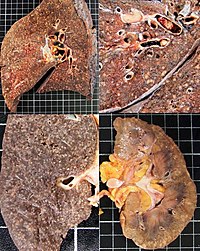
Photo from wikipedia
Simple Summary Tumour size is considered a key oncological feature, as it reflects the primary tumour burden. In pancreatic cancer, tumour size also constitutes the defining criterion for staging of… Click to show full abstract
Simple Summary Tumour size is considered a key oncological feature, as it reflects the primary tumour burden. In pancreatic cancer, tumour size also constitutes the defining criterion for staging of the primary tumour (T-stage), which provides essential information for patient treatment, risk stratification in clinical trials and cancer registries. While measurement of tumour size in pancreatic cancer resection specimens is considered accurate and reproducible, this has not been formally proven. This study investigated whether, and in how far, various approaches to tumour size measurement result in different tumour sizes and consequently different T-stages. The study findings show that tumour size and T-stage are different in a significant proportion of cases, depending on whether (i) the tumour was measured in one or two planes and (ii) the macroscopic tumour size was corroborated microscopically. Hence, a divergence in pathology practice may limit the comparability of tumour size and T-stage between institutions. Abstract In the eighth edition of the TNM classification for pancreatic ductal adenocarcinoma (PDAC), stages T1 to T3 are defined by tumour size, size measurement being deemed objective and accurate. This study investigated whether various, currently used approaches to tumour measurement result in different tumour sizes and differences in T-stage assignment. In a series of 315 resected PDAC, tumour sizes were measured as follows: macroscopically in a single or in two perpendicular planes and with or without microscopic corroboration. Comparison of the resulting tumour sizes showed that both macroscopic measurement in two planes and microscopic corroboration gave significantly different results (p < 0.001). Compared to the most simple approach (macroscopic measurement in one plane), the comprehensive approach (macroscopic measurement in two planes with microscopic corroboration) resulted in a larger tumour size in 263 (83%) cases (mean absolute size difference: 10 mm; mean relative size change: 36%). T-stage assignment differed in 142 (45%) cases between the simple and comprehensive approach and affected 87%, 38% and 48% of the cases deemed to be stage T1, T2 and T3, respectively. In conclusion, tumour size and T-stage are highly approach-dependent. Consensus on an accurate method is required to ensure comparability of these basic data.
Journal Title: Cancers
Year Published: 2022
Link to full text (if available)
Share on Social Media: Sign Up to like & get
recommendations!